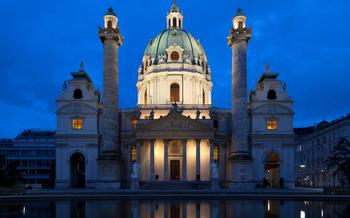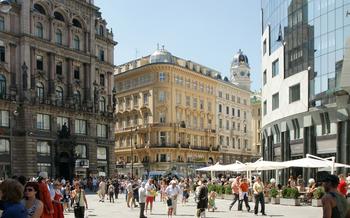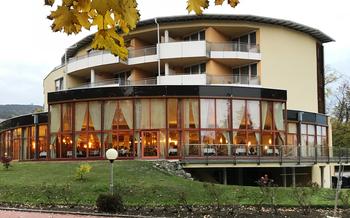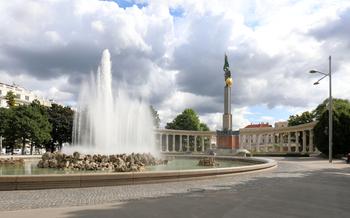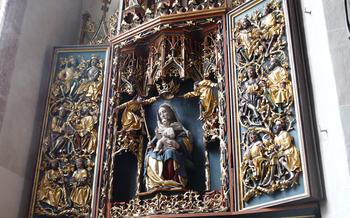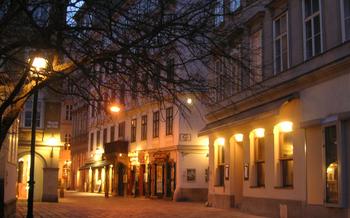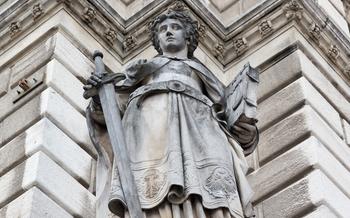
St. Charles's Church (Karlskirche)
- A Symbol of Viennese Baroque
- Masterpieces of Baroque Architecture
- The Karlskirche's Ceiling Frescoes
- The High Altar and Its Splendors
- The Borromean Family's Legacy
- St. Charles Borromeo's Oratory: A Sacred Sanctuary
- The Karlskirche's Musical Heritage
- The Karlskirche's Crypts and Catacombs
- Masses and Religious Services
- Visitor Information and Accessibility
- Location and Transportation
- Photo Opportunities and Instagrammable Spots
- Nearby Attractions and Points of Interest
- Suggested Itineraries and Tours
- Insider Tip: Hidden Gem
A Symbol of Viennese Baroque
St. Charles's Church, also known as the Karlskirche, stands as an architectural masterpiece and a testament to the grandeur of the Baroque period in Vienna. Its construction, initiated in the early 18th century, was deeply rooted in the historical context of the Catholic Reformation. The Counter-Reformation movement sought to strengthen the Catholic faith and counteract the rise of Protestantism. The church was commissioned by Emperor Charles VI, who dedicated it to Saint Charles Borromeo, a significant figure in the Catholic Church known for his dedication to the poor and the sick. The church's construction symbolized the Habsburg family's commitment to the Catholic faith and their desire to reassert the power of the Catholic Church in the region.
The Karlskirche's unique architectural features set it apart from other Baroque churches in Vienna. Its massive facade, adorned with intricate carvings and sculptures, depicts the Apotheosis of St. Charles Borromeo, emphasizing his ascent to heaven. The two bell towers, flanking the facade, soar upwards, creating a sense of grandeur and symmetry. The oval dome, a distinctive feature of the church, rests atop a tall drum and is covered with copper plates that glisten in the sunlight. The church's columns, with their elegant Corinthian capitals, add to its overall majesty and contribute to its reputation as a symbol of Viennese Baroque.
Masterpieces of Baroque Architecture
The St. Charles's Church stands as a testament to the grandeur and opulence of the Baroque period. Its facade is a masterpiece of architectural design, featuring a majestic portico with six towering columns. These columns, adorned with intricate carvings, support a triangular pediment that displays the emblem of the Borromean family, the church's patrons. The pediment is crowned by a statue of St. Charles Borromeo, the church's namesake, flanked by two angels.
The church's facade also features two bell towers, each topped by a slender spire. These towers add a vertical dimension to the church's silhouette, making it a prominent landmark in Vienna's cityscape. The harmonious interplay of curves and straight lines, as well as the balance and symmetry of the facade, showcase the architectural genius of Johann Bernhard Fischer von Erlach and his son.
Inside the church, the oval dome is a remarkable feature that sets it apart from other Baroque structures. The dome's interior is decorated with stunning frescoes by Johann Michael Rottmayr, depicting scenes from the life of St. Charles Borromeo. The illusionistic style of the frescoes creates a sense of depth and movement, drawing the viewer's gaze upwards. The dome is supported by four massive piers, each adorned with twisted columns and sculptural reliefs.
The Karlskirche's architectural design had a profound influence on other Baroque structures in Austria and beyond. Its unique blend of Italian and German Baroque elements created a new style that became known as Viennese Baroque. The church's innovative design inspired architects across Europe, contributing to the spread of the Baroque style throughout the continent.
The Karlskirche's Ceiling Frescoes
The St. Charles's Church is renowned for its breathtaking ceiling frescoes, the work of the renowned Austrian artist Johann Michael Rottmayr. The frescoes depict the Apotheosis of St. Charles Borromeo, a dynamic and awe-inspiring composition that captures the saint's ascent to heaven. Rottmayr's illusionistic style and mastery of perspective create a sense of depth and movement, drawing the viewer's gaze upwards towards the celestial realm.
The frescoes are a testament to Rottmayr's artistic genius and the Baroque period's love of grandeur and theatricality. The vibrant colors, intricate details, and expressive figures create a powerful visual narrative that celebrates the life and legacy of St. Charles Borromeo. The frescoes are not merely decorative elements but integral to the church's spiritual and artistic significance, inviting viewers to contemplate the saint's virtues and the promise of eternal salvation.
The Apotheosis of St. Charles Borromeo is a masterpiece of Baroque art and a must-see for any visitor to the Karlskirche. It is a testament to the enduring power of art to uplift and inspire, transcending the boundaries of time and space to connect us with the divine.
The High Altar and Its Splendors
As you step inside the Karlskirche, your gaze is immediately drawn to the awe-inspiring high altar, a masterpiece of Baroque artistry that commands attention. Created through the collaboration of the brilliant architect Johann Bernhard Fischer von Erlach and the renowned painter Martino Altomonte, this altar serves as the focal point of the church's opulent interior.
The high altar is a testament to the grandeur of the Baroque period, adorned with exquisite marble, intricate carvings, and gleaming gilding. Its central feature is a dramatic depiction of the martyrdom of St. Charles Borromeo, the church's patron saint. The painting, executed with masterful skill by Altomonte, captures the moment when St. Charles, while administering the sacraments during a plague, is struck down by a hail of arrows.
The altar's intricate details and symbolic elements add layers of meaning to this sacred space. The use of precious materials, such as marble, lapis lazuli, and gold, underscores the significance of St. Charles and the Catholic faith. The surrounding columns and sculptures further enhance the altar's grandeur, creating a sense of awe and reverence.
Standing before the high altar, one cannot help but be captivated by its beauty and spiritual power. It is a masterpiece that embodies the essence of the Baroque era, a testament to the artistic and religious fervor that defined this period in European history.
The Borromean Family's Legacy
The St. Charles's Church is closely intertwined with the history and legacy of the Borromean family, a prominent and influential noble family from Italy. The church was commissioned by Emperor Charles VI in honor of his uncle, St. Charles Borromeo, who was a significant figure in the Catholic Reformation and the Borromean family.
St. Charles Borromeo was born into the Borromean family, a wealthy and powerful clan from Milan. He became a cardinal in the Catholic Church and played a crucial role in the Council of Trent, which sought to reform the Catholic Church in response to the Protestant Reformation. He was also instrumental in establishing seminaries and promoting education within the Church.
The Borromean family's patronage was essential in the construction and embellishment of the St. Charles's Church. They contributed financially to the project and donated valuable artworks and relics. The church's design incorporates several Borromean symbols, including the family's coat of arms, which features three gold rings on a red background.
The Borromean family's influence can be seen throughout the church, from the grand facade to the intricate interior decorations. Their devotion to St. Charles Borromeo and their commitment to the Catholic Church are evident in every aspect of this magnificent Baroque masterpiece.
St. Charles Borromeo's Oratory: A Sacred Sanctuary
Within the grand expanse of the St. Charles's Church lies a hidden gem, a sacred space that exudes an aura of profound spirituality: the oratory of St. Charles Borromeo. This intimate chamber, tucked away from the bustling nave, served as a sanctuary for the saint's personal devotions, a place where he could commune with the divine in solitude.
The oratory, a testament to the saint's deep faith, is adorned with exquisite frescoes and intricate carvings that depict scenes from his life and martyrdom. The walls are lined with relics, including a fragment of St. Charles Borromeo's skull, adding a tangible connection to the saint's presence.
Visitors to the oratory are transported back in time, experiencing a palpable sense of the saint's devotion and spiritual journey. The atmosphere is one of contemplation and reverence, inviting visitors to connect with the legacy of St. Charles Borromeo and seek inspiration from his unwavering faith.
Whether seeking solace, spiritual guidance, or a deeper understanding of the saint's life, the oratory of St. Charles Borromeo offers a unique and profound experience. It is a place where history, art, and spirituality converge, creating a sacred space that resonates with the spirit of one of the Catholic Church's most beloved saints.
The Karlskirche's Musical Heritage
The St. Charles's Church is renowned for its strong ties to music and its role as a prominent concert venue. This legacy dates back to the 18th century when the church became associated with renowned composers such as Wolfgang Amadeus Mozart, Joseph Haydn, and Franz Schubert. These musical giants performed their masterpieces within the church's hallowed halls, leaving an indelible mark on its history.
The church's acoustics are particularly well-suited for musical performances, creating a resonant and immersive experience for listeners. As a result, the Karlskirche has become a popular venue for concerts, hosting performances by prestigious ensembles like the Vienna Boys' Choir and the Vienna Philharmonic. These concerts range from classical to contemporary music, showcasing the versatility of the church's acoustics.
Attending a concert at the Karlskirche is a unique and memorable experience. The combination of stunning architecture, exceptional acoustics, and world-class performances creates an atmosphere that is both awe-inspiring and intimate. Whether you're a classical music enthusiast or simply appreciate the power of music, a concert at the Karlskirche is an unforgettable event.
The Karlskirche's Crypts and Catacombs
Beneath the grandeur of the St. Charles's Church lie hidden secrets - the crypts and catacombs. These subterranean spaces hold a wealth of history and intrigue, inviting visitors to delve into the past. The crypts serve as the final resting place for prominent figures, including members of the Borromean family, who played a crucial role in the church's construction. The atmosphere in these underground chambers is palpable, with the weight of history pressing down.
Guided tours provide a unique opportunity to explore these hidden spaces and uncover their stories. Visitors can learn about the lives of those entombed here and gain insights into the customs and traditions of past centuries. The crypts offer a glimpse into the mortality of even the most illustrious individuals, reminding us of the transience of life.
The catacombs, with their labyrinthine tunnels and atmospheric lighting, offer a thrilling adventure for those seeking an off-the-beaten-path experience. These underground passages provide a glimpse into the lives of ordinary Viennese citizens, offering a unique perspective on the city's past.
Exploring the crypts and catacombs of the St. Charles's Church is a journey through time, allowing visitors to connect with the past and gain a deeper understanding of Vienna's rich history.
Masses and Religious Services
The St. Charles's Church remains an active place of worship, where the grandeur of Catholic ceremonies unfolds regularly. The church hosts daily masses and special services throughout the year, providing an opportunity for visitors to witness the spiritual and liturgical traditions of the Catholic faith.
Attending a mass at the St. Charles's Church is a profound experience, allowing visitors to immerse themselves in the sacred atmosphere and connect with the local religious community. The church's stunning interior, with its intricate frescoes and opulent decorations, creates a sense of awe and reverence that enhances the spiritual significance of the service.
For those seeking a deeper connection to the church's history and patron saint, special events and holidays offer a unique opportunity to participate in elaborate ceremonies and processions. These events showcase the rich cultural heritage of the church and provide a glimpse into the lives of the faithful who have worshipped within its walls for centuries.
Whether seeking spiritual fulfillment or cultural immersion, attending a mass or religious service at the St. Charles's Church is an enriching experience that offers a unique perspective on the enduring legacy of this magnificent Baroque masterpiece.
Visitor Information and Accessibility
When planning a visit to the St. Charles's Church, it is essential to consider practical information to ensure a smooth and enjoyable experience. The church offers guided tours that provide in-depth insights into its history, architecture, and religious significance. These tours are available in various languages and can be booked in advance or on-site.
For those who prefer self-guided exploration, audio guides are available for rent. These guides offer detailed commentary and explanations of the church's key features, allowing visitors to learn about its history and significance at their own pace.
The St. Charles's Church is committed to accessibility, ensuring that all visitors can enjoy its splendor. The church is wheelchair accessible, with ramps and elevators provided to enable easy movement throughout the building. Additionally, there are designated seating areas for individuals with disabilities, ensuring a comfortable and inclusive worship experience.
Admission fees are required for both guided tours and audio guide rentals, but discounts are available for students, seniors, and families. It is recommended to check the church's official website for the most up-to-date information on admission fees and tour schedules.
Location and Transportation
The St. Charles's Church is strategically located in the heart of Vienna, making it easily accessible by various means of transportation. Visitors can conveniently hop on the U-Bahn (metro) lines U1, U2, or U4 and alight at the Karlsplatz station, which is just a short walk away from the church. Several tram lines, including the 1, 2, and D, also stop nearby, providing a scenic and convenient mode of transportation. If you prefer to explore the city on foot, the church is within easy walking distance from major landmarks such as the Belvedere Palace, the State Opera House, and the Naschmarkt, allowing you to combine your visit with a leisurely stroll through Vienna's historic center. Whether you choose to arrive by public transportation or on foot, the Karlskirche's central location ensures a seamless and enjoyable visit.
Photo Opportunities and Instagrammable Spots
The St. Charles's Church is a photographer's paradise, offering an abundance of Instagrammable moments. From the intricate details of the facade to the awe-inspiring frescoes within, every corner of the church is a potential masterpiece.
Step outside and capture the church's impressive silhouette against the backdrop of the Viennese sky. The two bell towers, reaching towards the heavens, make for a striking composition. As the sun sets, the golden hues bathe the facade in a warm glow, creating a magical atmosphere.
Inside the church, the ceiling frescoes by Johann Michael Rottmayr are a feast for the eyes. The illusionistic style and the use of perspective create a sense of depth that is truly breathtaking. Capture the intricate details of the frescoes, from the angelic figures to the symbolic representations.
Don't miss the high altar, with its opulent marble and gilding. The dramatic lighting enhances the altar's grandeur, making it a perfect subject for a photo. Zoom in on the intricate carvings and the expressive faces of the sculptures to capture the essence of this Baroque masterpiece.
Share your Instagrammable moments with the world using #Karlskirche or #ViennaBaroque. Connect with other travelers and art enthusiasts who appreciate the beauty of this architectural gem. Let your photos inspire others to explore the hidden treasures of Vienna.
Nearby Attractions and Points of Interest
Beyond the St. Charles's Church, Vienna offers a plethora of attractions and landmarks within easy reach. Indulge in the grandeur of the nearby Belvedere Palace, housing an impressive art collection. Explore the captivating Museum of Military History, showcasing Austria's rich military heritage. Immerse yourself in the world of music at the renowned Musikverein, home to the Vienna Philharmonic Orchestra. Discover the stunning Karlskirche, an architectural masterpiece renowned for its striking Baroque facade.
For a comprehensive cultural experience, stroll through the historic center of Vienna, a UNESCO World Heritage Site. Admire the grandeur of St. Stephen's Cathedral, the symbol of Vienna, with its intricate Gothic architecture. Marvel at the opulent Hofburg Palace, the former imperial residence of the Habsburg dynasty. Immerse yourself in the vibrant art scene at the Kunsthistorisches Museum and the Albertina, showcasing masterpieces from across the centuries.
Create your personalized itinerary by combining a visit to the St. Charles's Church with other nearby attractions. Craft a day filled with history, art, and culture, exploring the rich tapestry of Vienna's heritage.
Suggested Itineraries and Tours
Embrace the Grandeur of Vienna's Architectural Masterpieces
For an immersive experience, consider a guided tour of the St. Charles's Church. Expert guides will unveil the intricate details, fascinating stories, and symbolism behind the church's architecture, frescoes, and altars. Alternatively, create a self-guided tour using available audio guides or informative brochures. Take your time to admire the church's grandeur, capturing every angle and detail.
To fully appreciate Vienna's architectural heritage, combine your visit with other notable landmarks. Start at the nearby Belvedere Palace, home to the Austrian Gallery Belvedere and its impressive collection of Austrian art. Continue to the majestic Hofburg Palace, the former imperial residence, and explore its museums, courtyards, and gardens. End your architectural journey at the stunning Schönbrunn Palace, a UNESCO World Heritage Site, and marvel at its opulent interiors and sprawling gardens.
For a comprehensive exploration of Vienna's rich history and culture, opt for a Vienna Pass. This pass grants access to over 60 top attractions, including the St. Charles's Church, Belvedere Museum, Hofburg Palace, and Schönbrunn Palace. With skip-the-line privileges and discounts on additional attractions, the Vienna Pass offers convenience, savings, and a hassle-free way to experience the city's highlights.
Insider Tip: Hidden Gem
St. Charles's Church holds a secret treasure that often goes unnoticed by visitors: the Borromean Library. Located in the former residence of the Borromeo family, this hidden gem houses a collection of over 15,000 rare books and manuscripts, many of which date back to the 16th and 17th centuries. The library is a treasure trove for scholars and history enthusiasts, offering a glimpse into the intellectual and religious life of the Borromeo family and their influence on the Counter-Reformation. While the library is not always open to the public, guided tours can be arranged upon request, providing a unique opportunity to explore this hidden gem and delve deeper into the history of the St. Charles's Church.
